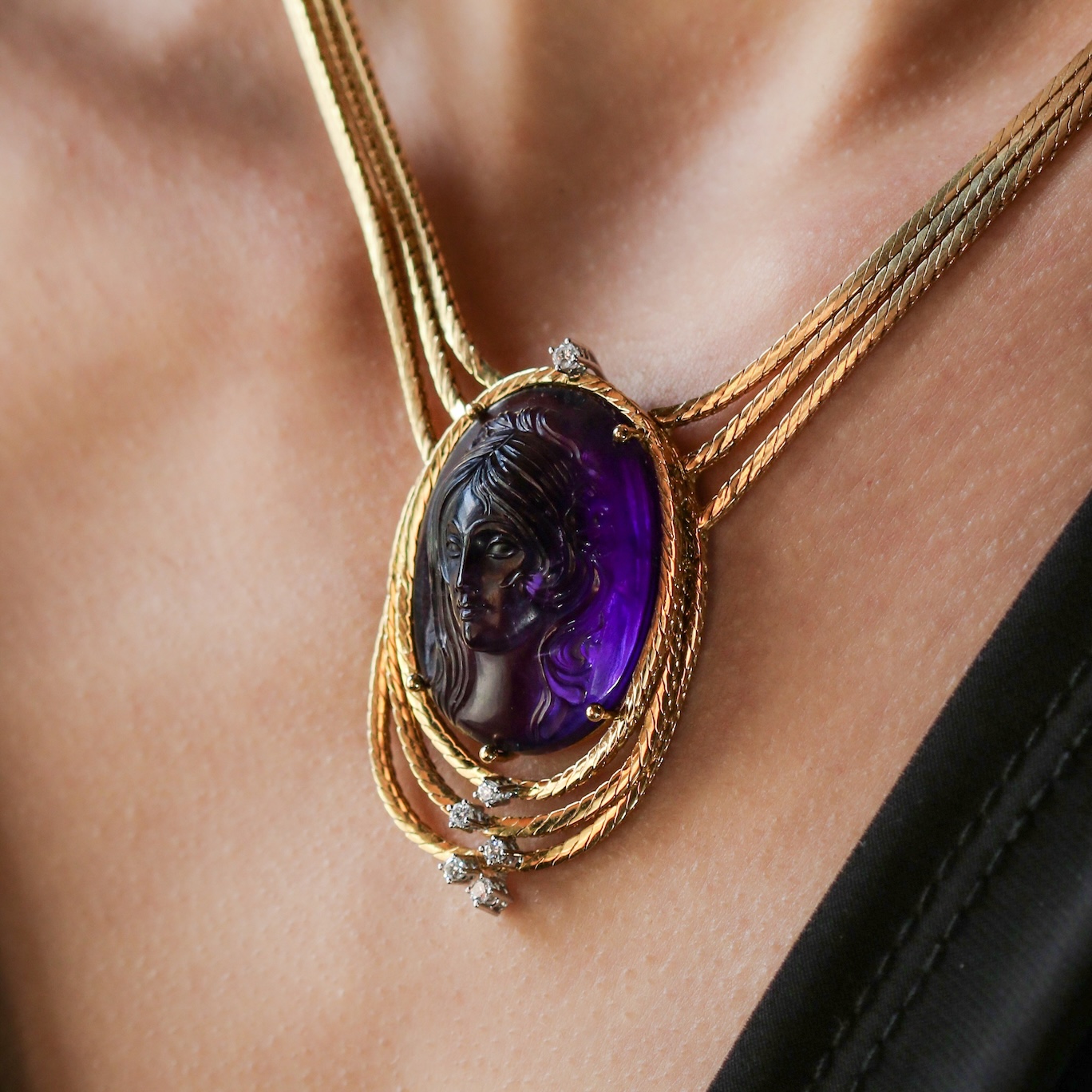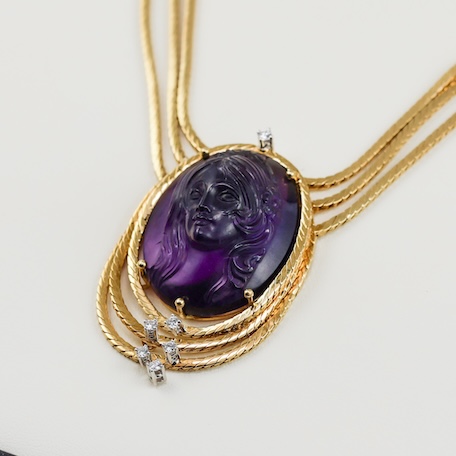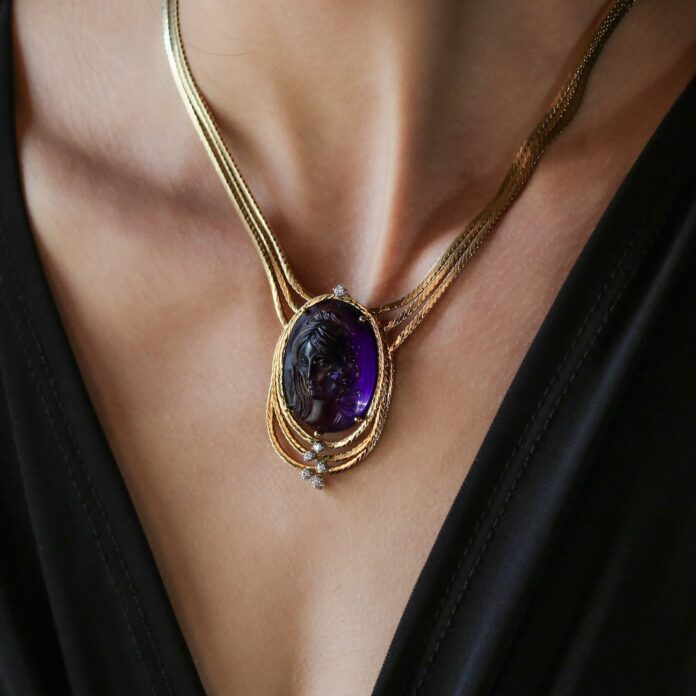February’s Birthstone, The Rich History and Symbolism of Amethyst
According to Greek mythology, the story of amethyst’s origin is linked to Dionysus, the god of wine and revelry
by Joseph Denaburg, Levy’s Fine Jewelry
Amethyst the birthstone of February, is a member of the quartz family, renowned for its captivating purple hue. Ranging in color from delicate lilac to deep, rich violet with red or bluish undertones, this gemstone has long been associated with sincerity, wisdom, and sacred love.
A Gemstone Fit for Royalty
Dating back to the Minoan Civilization (2500 BC), amethyst was once considered as valuable as diamonds. This changed in the 19th century when vast deposits were discovered in Brazil, making the gemstone more widely accessible. However, its historical prestige remains undeniable. Amethyst has adorned royal jewelry for centuries, from the treasures of Ancient Egypt to the British Crown Jewels. According to legend, it was also the favorite gemstone of Catherine the Great of Russia, further cementing its reputation as a stone of nobility.

The value of amethyst is largely determined by its color, with darker, more intense shades commanding higher prices than their lighter counterparts. The gemstone registers a 7 on the Mohs scale of hardness, making it a durable choice for jewelry. Today, amethysts are commonly sourced from Brazil, Uruguay, South Korea, Russia, India, Zambia, and the United States.
The Greek Legend of Amethyst and Dionysus
The name “amethyst” originates from the Greek word améthystos, meaning “without intoxication.” Since ancient times, the stone has been associated with protection against drunkenness and excess.
According to Greek mythology, the story of amethyst’s origin is linked to Dionysus, the god of wine and revelry (known as Bacchus in Roman mythology). The philosopher Aristotle recorded a tale of a beautiful nymph named Amethystos, who sought refuge from the intoxicated wrath of Dionysus by praying to the goddess Diana. In response, Diana transformed the nymph into a clear quartz crystal. Overcome with remorse, Dionysus poured wine over the stone, staining it a deep purple and giving birth to the amethyst we know today.
Amethyst in Ancient Egypt and Roman Culture
In Ancient Egypt, amethyst was frequently used as a protective talisman. Soldiers often wore amulets made from this gemstone, believing it would bring them victory and keep them calm in battle. The Roman author Pliny documented that the Magi (ancient priests and astrologers) viewed amethyst as a powerful charm when engraved with sun and moon symbols. They believed it protected against witchcraft, misfortune, and bad luck, while also helping the wearer gain favor with authority figures.
Amethyst’s Role in the Church
Due to its frequent use in Episcopalian jewelry, particularly rings worn by bishops, amethyst earned the title “The Bishop’s Stone.” It was believed to symbolize piety, humility, and divine wisdom. Amethyst rosaries were also widely used, thought to reduce stress and bring a deep sense of calm to those who wore them.
The stone is closely tied to St. Valentine, who is said to have always worn an amethyst ring engraved with the image of Cupid. It is also the symbolic stone of St. Matthias and the Guardian Angel Adnachiel. Additionally, amethyst was one of the twelve gemstones adorning the breastplate of the High Priest Aaron, as described in the Old Testament (Exodus 39).
Medieval Beliefs About Amethyst
During the Middle Ages, amethyst was believed to have mystical properties. It was thought to detect poisons by changing color when exposed to toxins. People also believed that if the gemstone faded, it was a sign of personal danger or ill-health.
Amethyst was particularly associated with love and good fortune. A common belief held that if a bride gifted her spouse an amethyst heart set in silver, the couple would enjoy lifelong happiness and prosperity. The stone was also thought to strengthen the resolve of businessmen and provide courage to soldiers during times of war.
Even Leonardo da Vinci was captivated by the properties of amethyst, believing it had the power to enhance intelligence and guard against evil thoughts.

Amethyst in Chinese Culture and Feng Shui
In traditional Chinese medicine, amethyst has long been prescribed for healing ailments such as lung conditions, stomach pain, and nightmares. The stone was believed to have the power to purify the body, particularly in the chest area, and to relieve headaches while improving mental clarity.
In Feng Shui, amethyst is considered an enhancer of the wealth corner, encouraging the giving and receiving of material abundance. Many practitioners place amethyst crystals in their homes or offices to attract prosperity and success.
Fascinating Amethyst Facts
Amethyst is the official gemstone of Ontario, Canada.
The Hebrew word for amethyst, “ahlamah,” means “dream,” as the stone was believed to bring prophetic visions and restful sleep.
The world’s largest amethyst geode, measuring nearly 10 feet tall and weighing 13 tons, is displayed at the Shandong Tianyu Museum of Natural History in China.
From its royal history to its spiritual significance, amethyst remains one of the most beloved gemstones in the world. Whether worn for its beauty, protective qualities, or symbolic meaning, it continues to captivate wearers across cultures and generations.




























